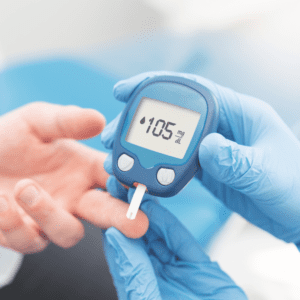
What is the treatment for insulin resistance in the body?
What is insulin resistance?
The pancreas releases the hormone insulin, which aids in controlling blood glucose levels. When your body doesn’t make enough insulin or when cells become resistant to insulin’s effects, blood sugar levels can rise. This condition is known as “insulin resistance”. Insulin resistance may not cause any signs or symptoms on its own. But it increases your risk for type 2 diabetes and heart disease, so it’s important to be aware of this health concern and take steps to manage it.(1)
Insulin resistance is a condition in which the body’s cells no longer respond normally to insulin
the hormone that enables glucose to enter the cells for use as fuel. The pancreas then produces more insulin to help overcome this resistance, but eventually it can become unable to produce enough insulin to overcome this resistance. This leads to hyperglycemia (high blood sugar), which has many adverse effects on body organs and systems over time.
A diagnosis of type 2 diabetes is usually made when a person has an elevated fasting blood glucose level or an elevated A1C. A second test on a different day can confirm this.(2)
What is a great insulin-resistant lifestyle?
Take your meds consistently. Take your medication as prescribed.
If you forget to take your medication, contact your doctor or pharmacist for instructions on how to handle the situation.
Be sure to store medications in an area where they will not be exposed to light or heat (such as the bathroom medicine cabinet).
Never take more than the recommended dose of any medication unless your doctor advises otherwise. Do not share your medications with other people or allow them to use them without a prescription from a doctor.
If you are not sure whether to take medication or how much to take, ask your doctor. Do not change the amount of any prescription drug unless your doctor recommends it.
If you have a question about whether to take a medicine, ask your doctor or pharmacist.
Get some exercise.
Exercising regularly can help you lose weight and improve your insulin sensitivity. But it’s important to know that not all exercise is created equal when it comes to managing insulin resistance.
To get the most out of your workouts, aim for at least 30 minutes of moderate-intensity aerobic activity every day. That means you should be able to talk or sing while exercising, but not so hard that you must stop for breath every few words! You should also do strength training twice a week, and some research has even shown that just five minutes of high-intensity interval training (HIIT) each day may offer the same benefits as longer sessions of low-intensity aerobic exercise.
You don’t need any special equipment—just pick something fun like Zumba®, kickboxing, or running on a treadmill! (4)
Losing weight is primarily a good way to treat insulin resistance
To improve insulin resistance, you need to lose weight. This can be achieved through a combination of diet and exercise. The benefits of losing weight are well established: improved heart health, lower blood pressure, and lower cholesterol levels.
However, it is important for you to lose weight in the right way so as not to make your condition worse. Losing too much weight very quickly may increase your risk of developing osteoporosis (a disease that causes brittle bones) or other complications associated with a low body fat percentage (such as weak muscles). It’s also important that you do not stop exercising when you reach your goal weight; regular activity helps maintain muscle mass and improves metabolism—both of which help keep insulin resistance at bay for years after reaching your target number on the scale.
A healthy diet is also essential for managing insulin resistance.
You should focus on eating a variety of foods from all the major food groups (fruits, vegetables, grains, and proteins). This will ensure that you get a balanced mix of nutrients. In addition, it’s important to limit your intake of saturated fats and trans fats—these are bad for your heart health.
Follow a healthy diet plan to treat insulin resistance
Eating a healthy diet is an important part of managing your weight and preventing insulin resistance. Follow these guidelines:
Eat a low-fat, high-fiber diet. A diet low in fat and high in fiber can help you lose weight and keep it off. Choose foods that are lower on the glycemic index scale, which means they cause a gradual rise in blood glucose levels (blood sugar). For example, choose whole grains instead of processed foods or fast food; fruits instead of fruit juices; nuts and seeds instead of chocolate candy bars.
Limit sugary drinks such as soda pop to no more than one serving per day for women and two servings for men (about 6 ounces each). Sugary drinks are full of empty calories that can lead to weight gain if consumed regularly, increasing your risk for insulin resistance along with other health problems related to being
such as heart disease, stroke, or type 2 diabetes mellitus (T2DM).
Eat small meals throughout the day rather than three large ones—this keeps blood glucose levels higher throughout the day while helping keep hunger at bay, so you don’t overeat later in the evening after dinner time has passed.
If you must eat a large meal, eat it early in the day to avoid going to bed on an empty stomach. Eating smaller meals throughout the day also helps keep your blood sugar levels more even and prevents peaks and troughs in insulin production that can lead to weight gain over time.
Eat more fiber-rich foods. Including fiber in your diet helps control blood sugar levels by slowing down the absorption of glucose into the bloodstream, which in turn keeps insulin production at a lower level throughout the day.
If you have insulin resistance, there are steps you can take to improve or reverse it. Start with the basics:
Eat healthy. Choose whole grains, fruits, and vegetables instead of processed foods that are high in sugar and low in nutrients.
Exercise regularly—aim for 30 minutes on most days of the week (exercising less than this is not effective).
Follow your doctor’s instructions when taking your medications.
Conclusion
If you’re experiencing insulin resistance, it’s important to seek medical advice from your doctor or registered dietitian. A diagnosis of diabetes may be made if more than three blood glucose tests in a year show a fasting blood sugar level of 126 milligrams per deciliter (mg/dL) and above on two separate occasions. The good news is that there are several ways to manage insulin resistance and its associated conditions, including by taking medication, eating well, and staying active.


